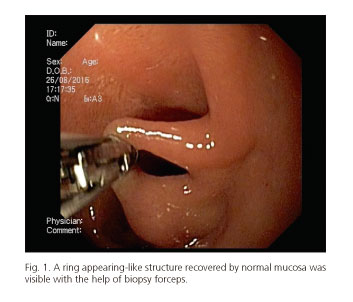Mi SciELO
Servicios Personalizados
Revista
Articulo
Indicadores
-
 Citado por SciELO
Citado por SciELO -
 Accesos
Accesos
Links relacionados
-
 Citado por Google
Citado por Google -
 Similares en
SciELO
Similares en
SciELO -
 Similares en Google
Similares en Google
Compartir
Revista Española de Enfermedades Digestivas
versión impresa ISSN 1130-0108
Rev. esp. enferm. dig. vol.109 no.5 Madrid may. 2017
PICTURES IN DIGESTIVE PATHOLOGY
Does it "ring" a Brunner's gland bell?
Eduardo Rodrigues-Pinto and Guilherme Macedo
Gastroenterology Department. Centro Hospitalar São João. Porto, Portugal
Author contributions: Dr. Rodrigues-Pinto performed the endoscopic procedure. Both authors participated in drafting and critical revision of the manuscript for important intellectual content.
Case report
A 68-year-old female patient with a past medical history of chronic gastritis underwent an upper endoscopy for surveillance. A ring appearing-like structure covered with normal mucosa was found in the duodenum bulb (Fig. 1). Histology demonstrated Brunner's gland hyperplasia without dysplasia or malignancy.
Discussion
Mucosal bridge formation is an uncommon condition, characterized by bridging of two parts of the lumen that is believed to result from mucosal injury. It has been reported in colon, esophagus and stomach following inflammatory events (1-3). Inflammatory bowel disease, ischemic and infectious diseases, as well as ingestion of corrosive agents or radiation therapy, have been identified as possible causes. Pathogenesis of the mucosal bridge is possibly related to the undermining of the mucosa by ulceration followed by healing with re-epithelization of the mucosal undersurface and formation of a mucosal tube that is attached at each end to the non-ulcerated wall, persisting even after resolution of underlying disease. On histology, the mucosal bridge is characterized by chronic inflammation. On microscopy, the mucosal bridge is characterized by chronic inflammation. To our knowledge, this is the first case that reports a duodenal mucosal bridge. It may be associated with a past medical history of peptic ulcer disease (not mentioned) with Brunner's gland hyperplasia being an incidental finding. Brunner's gland is a submucosal, alkaline-secreting gland that is usually located in the duodenum bulb. Brunner's gland hyperplasia/hamartoma is a common disease in the duodenum found in the 5th or 6th decade of life, but it rarely causes complications such as hemorrhage, obstruction, or intussusceptions.
References
1. Gupta G, Nijhawan S, Chander S, et al. Colonic mucosal bridging in ulcerative colitis. Indian J Gastroenterol 2012;31:39. DOI: 10.1007/s12664-012-0168-2. [ Links ]
2. Van Moerkercke W, Deboever G, Lambrecht G, et al. Severe bridging fibrosis of the colon in a man with inflammatory bowel disease. Endoscopy 2007;39:E294. DOI: 10.1055/s-2007-966418. [ Links ]
3. Salamun E, Gröchenig HP, Langner C. Mucosal bridge formation in a patient with esophageal epidermoid metaplasia. Endoscopy 2016;48:E325. DOI: 10.1055/s-0042-117225. [ Links ]














